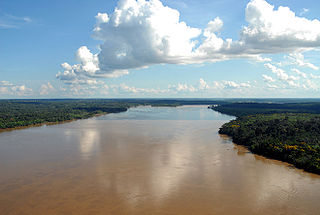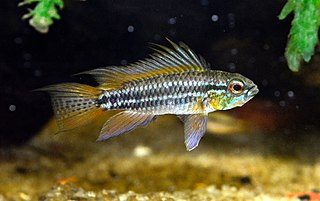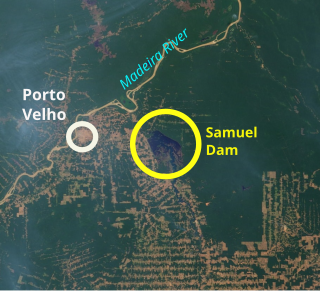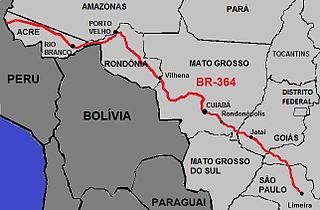
The country of Brazil occupies roughly half of South America, bordering the Atlantic Ocean. Brazil covers a total area of 8,514,215 km2 (3,287,357 sq mi) which includes 8,456,510 km2 (3,265,080 sq mi) of land and 55,455 km2 (21,411 sq mi) of water. The highest point in Brazil is Pico da Neblina at 2,994 m (9,823 ft). Brazil is bordered by the countries of Argentina, Bolivia, Colombia, Guyana, Paraguay, Peru, Suriname, Uruguay, Venezuela, and French Guiana.

The Madeira River is a major waterway in South America. It is estimated to be 1,450 km (900 mi) in length, while the Madeira-Mamoré is estimated near 3,250 km (2,020 mi) or 3,380 km (2,100 mi) in length depending on the measuring party and their methods. The Madeira is the biggest tributary of the Amazon, accounting for about 15% of the water in the basin. A map from Emanuel Bowen in 1747, held by the David Rumsey Map Collection, refers to the Madeira by the pre-colonial, indigenous name Cuyari.
The River of Cuyari, called by the Portuguese Madeira or the Wood River, is formed by two great rivers, which join near its mouth. It was by this River, that the Nation of Topinambes passed into the River Amazon.

Amazonas is a state of Brazil, located in the North Region in the north-western corner of the country. It is the largest Brazilian state by area and the ninth-largest country subdivision in the world. It is the largest country subdivision in South America, being greater than the areas of Chile, Paraguay, and Uruguay combined. Neighbouring states are Roraima, Pará, Mato Grosso, Rondônia, and Acre. It also borders the nations of Peru, Colombia and Venezuela. This includes the Departments of Amazonas, Vaupés and Guainía in Colombia, as well as the Amazonas state in Venezuela, and the Loreto Region in Peru.

Rondônia is one of the 26 states of Brazil, located in the northern subdivision of the country. It is bordered by Acre in the west, Amazonas in the north, Mato Grosso in the east, and Bolivia in the south. Rondônia has a population of 1,815,000 as of 2021. It is the fifth least populated state. Its capital and largest city is Porto Velho, bathed by the Madeira River. The state was named after Cândido Rondon, who explored the north of the country during the 1910s. The state, which is home to c. 0.7% of the Brazilian population, is responsible for c. 0.3% of the Brazilian GDP.

The Chapacuran languages are a nearly extinct Native American language family of South America. Almost all Chapacuran languages are extinct, and the four that are extant are moribund, with the exception of Wari'. They are spoken in Rondônia in the southern Amazon Basin of Brazil and in northern Bolivia.

Marshal Cândido Mariano da Silva Rondon was a Brazilian military officer most famous for his telegraph commission and exploration of Mato Grosso and the western Amazon basin, as well as his lifelong support for Indigenous Brazilians. He was the first director of Brazil's Indian Protection Service or SPI and supported the creation of the Xingu National Park. The Brazilian state of Rondônia is named after him.

Apistogramma is a large genus of freshwater fish in the family Cichlidae native to South America, but also commonly kept in aquariums. They are dwarf cichlids that mostly feed on tiny animals and have breeding behaviors that vary depending on the exact species.

Mikrogeophagus altispinosus is a species of fish endemic to the southern Amazon River basin in Brazil and Bolivia. The species is part of the family Cichlidae and subfamily Geophaginae. It is a popular aquarium fish, traded under the common names Bolivian butterfly, Bolivian ram, Bolivian ram cichlid, and ruby crown cichlid.

Hoplarchus is a genus of cichlid in the tribe Heroini. It contains the single species Hoplarchus psittacus, which is endemic to the blackwater rivers in Brazil, Colombia and Venezuela, including the Rio Negro, Jamari, Preto da Eva, Urubu rivers and upper Orinoco drainages. This fish can reach a length of 35 centimetres (14 in) TL and is important as a food fish to local indigenous peoples. This species is occasionally kept as an aquarium fish and is traded under the common name "parrot cichlid".
Aikanã is an endangered language isolate spoken by about 200 Aikanã people in Rondônia, Brazil. It is morphologically complex and has SOV word order. Aikanã uses the Latin script. The people live with speakers of Koaia (Kwaza).

The Jamari River is a river of Rondônia state in western Brazil.

The Ji-Paraná River, sometimes spelled Jiparaná, is a river in Rondônia state in western Brazil. It is a tributary of the Madeira River in the Amazon Basin. For much of its length it runs roughly parallel with the northeastern state border of Rondônia. The city of Ji-Paraná is divided by the river.
The Rio Verde is a river of Rondônia state in western Brazil. It is a tributary of the Jamari River.

The Amazon biome contains the Amazon rainforest, an area of tropical rainforest, and other ecoregions that cover most of the Amazon basin and some adjacent areas to the north and east. The biome contains blackwater and whitewater flooded forest, lowland and montane terra firma forest, bamboo and palm forest, savanna, sandy heath and alpine tundra. Some areas of the biome are threatened by deforestation for timber and to make way for pasture or soybean plantations.
The Samuel Ecological Station is a strictly protected ecological station in the state of Rondônia, Brazil. It contains a tract of Amazon rainforest that extends east from the reservoir formed by the Samuel Hydroelectric Dam.

The Samuel Hydroelectric Dam is a 216 MW hydroelectric dam near Porto Velho, Rondônia, Brazil. The project was controversial since it had a major environmental impact and during operations released more greenhouse gases than a comparable oil-fuelled plant.

BR-364 is an inter-state highway in Brazil connecting the southeast state of São Paulo to the western state of Acre. The highway was opened in the 1960s and paved in the 1980s. It has brought economic development and population growth in the Amazon basin states of Rondônia and Acre. It is also important for the flow of agricultural and livestock production in the states of Rondônia, Mato Grosso and Goiás, for Brazilian domestic consumption and for export, predominately by Port of Santos.
The Bom Futuro National Forest is a national forest in the state of Rondônia, Brazil. The forest has been subject to a massive invasion of loggers, ranchers and farmers.

Coccoloba gigantifolia is a species of flowering plant in the knotweed family Polygonaceae. It is endemic to the Madeira River Basin in the states of Amazonas and Rondonia in the central and southwestern Brazilian Amazon. This species resembles that of Coccoloba mollis but differs in that it has much larger leaves in its fertile branches.















